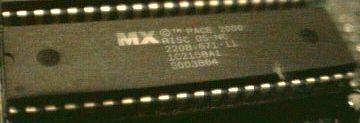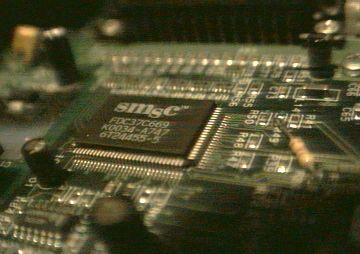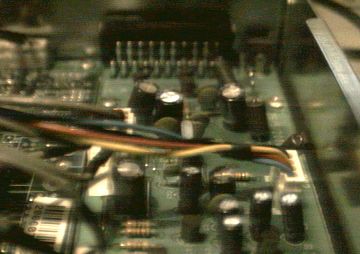
|
Gutted!
|

|
Guts...
So far, lots of guesswork...

CPU and ROMs
Possibly the most interesting picture (!), there are several things of note here. In the very
front of the picture is an 8Mb SIMM. As your web fetches are stored in CacheFS in memory (think
of a smart resizable RAMdisc designed for storing web stuff), more memory might be a benefit,
but 8Mb is a pretty impressive starting figure!
Middle left. The big square thing is an ARM7500FE. This piece of silicon contains an ARM7500
macrocell (basically an ARM7), hardware floating point (barely used by the box!), IOMD, and the
VIDC2, and can access EDO style memory.
| Middle right. The two ROMs for RISC OS-NC. It should be mostly compatible with a
RiscPC version of RISC OS, but the hardware is sufficiently different that swapping
ROMs simply wouldn't work. |
 |
Top right (behind the cable bundle). The IIC NVRAM. There is no RTC, so RISC OS will always
think it is January 1970. A little module sets up the standard 'CMOS RAM' options at each boot
up, and restores other stuff. That's why you can't configure different mice, or unplug modules,
and how it remember any of it.
The NVRAM is a 4096 x 8 device. This holds your dial-up settings, and the 'favourites'. The
space is finite, so adding a new favourite without enough space will cause the first favourite
to be discarded. Moral: use favourites wisely.
Top left. Can you see SMC? Yes? That looks familiar! Let's zoom in a little...

FDC37C669
This is an FDC37C669. If that doesn't seem familiar after all, you maybe have not read the
document on hardware interfacing yet. This is an ISA 'combo' chip,
similar to the one used in the RiscPC (FDC37C665) or the RiscStation (FDC37C666). It provides
here the parallel port, and also the interface to the keyboard - I guess that is why they used
the chip with the on-board infra-red gubbins.
I'm not sure if the modem is addressed directly, or if communication is done via serial which is
routed to the modem hardware. Yeah, it sounds yucky to use serial but it'd offer the quickest
path (else you'd need to twiddle stuff to hook the serial data and translate it to modemese).
Maybe I shouldn't mention the 37C669 also offers a floppy disc interface, an IDE harddisc
interface, another serial port, and some other nice stuff. :-)
Looking to the left...

The modem
The 33,600bps modem is implemented as a podule, and is fitted directly onto the motherboard.
And, finally, to the right...

Video and power
The power supply does not consist of much. The plug-in box is a switchmode power supply that will
output a regulated 6V (2.5A, 15W), so not much needs to be done internally. The power unit will
work on anything from 100V to 240V. The IBX-100 box itself only requires 6W. :-)
The video circuitry is on a seperate board, sharing space with the power circuitry. I suspect the
final video stuff is seperate as it would be easier to alter things for different television
systems - simply make a different video board instead of altering the motherboard.
Return to the index
Copyright © 2002 Richard Murray








